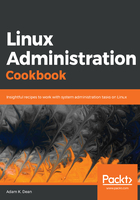
There's more...
The concept of enabled and disabled is relatively easy to understand, those states being that the service will either try to run or it won't.
static is something different; this is the terminology used when a unit file exists, isn't enabled, but has no ability to become enabled, owing to a missing [Install] section of its unit file.
We can list these services with the following line:
$ systemctl --no-pager list-unit-files --type service --state static
Taking a service at random (sshd-keygen), we can have a look at its service file like so:
$ systemctl cat sshd-keygen.service
We get the following:
# /usr/lib/systemd/system/sshd-keygen.service
[Unit]
Description=OpenSSH Server Key Generation
ConditionFileNotEmpty=|!/etc/ssh/ssh_host_rsa_key
ConditionFileNotEmpty=|!/etc/ssh/ssh_host_ecdsa_key
ConditionFileNotEmpty=|!/etc/ssh/ssh_host_ed25519_key
PartOf=sshd.service sshd.socket
[Service]
ExecStart=/usr/sbin/sshd-keygen
Type=oneshot
RemainAfterExit=yes
From this file, we can see it has a PartOf definition, suggesting it's run as part of the sshd service.
Taking a look at that service (again using systemctl cat) reveals the following:
# /usr/lib/systemd/system/sshd.service
[Unit]
Description=OpenSSH server daemon
Documentation=man:sshd(8) man:sshd_config(5)
After=network.target sshd-keygen.service
Wants=sshd-keygen.service
[Service]
Type=notify
EnvironmentFile=/etc/sysconfig/sshd
ExecStart=/usr/sbin/sshd -D $OPTIONS
ExecReload=/bin/kill -HUP $MAINPID
KillMode=process
Restart=on-failure
RestartSec=42s
[Install]
WantedBy=multi-user.target
We can see the Wants section here, suggesting sshd-keygen is run when sshd starts.
This explains why it doesn't have to be enabled on its own.